

Wprowadzenie Polityki Otwartego Dostępu w Narodowym Centrum Nauki. W nawiązaniu do stanowiska Rady NCN popierającego dążenia Dyrektora Narodowego Centrum Nauki do wprowadzenia Polityki dotyczącej publikowania w otwartym dostępie wyników będących efektem realizacji badań finansowanych lub współfinansowanych ze środków publicznych (zwanej dalej Polityka OA) miło nam poinformować, że Polityka OA została wprowadzona Zarządzeniem Dyrektora nr 40/2020 w dniu 31 maja br.
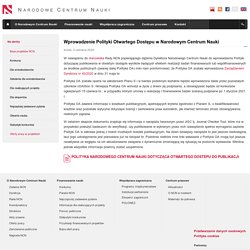
Polityka OA została oparta na założeniach Planu S i w bardzo podobnym kształcie będzie wprowadzona także przez pozostałych członków cOAlition S. ZarzadzenieDyr 38 2020. The end of the paywall in science - scilog. The Austrian Science Fund FWF has worked to promote free and open access to scholarly knowledge for the last 15 years.

Its funding policies have helped to bring about a long overdue cultural shift in publishing practice. Now “Plan S” is being launched, a new initiative to finally ring in an era of Open Science. For some time now, there have been rumblings in the academic publishing industry, and they have grown loud enough for the wider public to realise that there is a need for structural change in this field. The main reason is that the scholarly publishing sector has seen the emergence of near-monopolies in the last few decades. This is not surprising given the enormous growth of the market for research publications over the same time. Monopolisation and paywalls Costs in this area have been seen to rise significantly faster than the general inflation rate. Zmiany w Planie S. Znane są już zmiany wprowadzone do Planu S po publicznych konsultacjach, które zakończyły się na początku lutego tego roku.
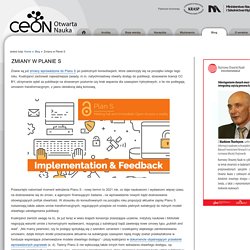
6c2249ded8b235e9df1430008d8f8eb5. Better Sharing Through Licenses? Measuring the Influence of Creative Commons Licenses on the Usage of Open Access Monographs. Research Article Author: Ronald Snijder.
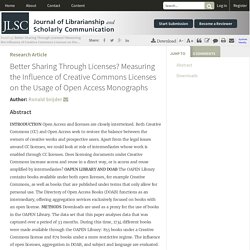
DOAJ EDITORS ON THE EFFECTS OF THE NEW DOAJ CRITERIA – News Service. This is a guest post by Andrea Marchitelli, Paola Galimberti and Andrea Bollini, who write about their experience of being DOAJ editors and their published paper: “Helping journals to improve their publishing standards: a data analysis of DOAJ new criteria effects” After DOAJ implemented new criteria for inclusion of open access journals and invited all journals listed in the directory to reapply, a large number of journals was removed from the database, most for failing to submit an updated application within the deadline.
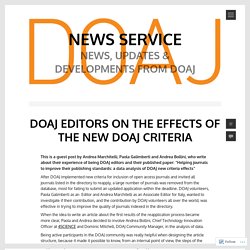
DOAJ volunteers, Paola Galimberti as an Editor and Andrea Marchitelli as an Associate Editor for Italy, wanted to investigate if their contribution, and the contribution by DOAJ volunteers all over the world, was effective in trying to improve the quality of journals indexed in the directory. Helping journals to improve their publishing... Abstract In 2013, Directory of Open Access Journals (DOAJ) expanded and updated its inclusion criteria and its journal evaluation process, ultimately removing a large number of journals that failed to submit an updated application.
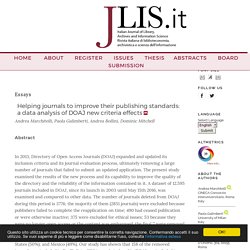
The present study examined the results of the new process and its capability to improve the quality of the directory and the reliability of the information contained in it. Directory of Open Access Journals. Art przeczytać. Bill & Melinda Gates Foundation Open Access Policy. The Bill & Melinda Gates Foundation is committed to information sharing and transparency.
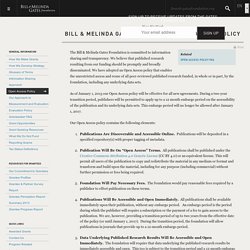
We believe that published research resulting from our funding should be promptly and broadly disseminated. We have adopted an Open Access policy that enables the unrestricted access and reuse of all peer-reviewed published research funded, in whole or in part, by the foundation, including any underlying data sets. As of January 1, 2015 our Open Access policy will be effective for all new agreements. During a two-year transition period, publishers will be permitted to apply up to a 12 month embargo period on the accessibility of the publication and its underlying data sets. This embargo period will no longer be allowed after January 1, 2017. OPEN ACCESS JOURNALS IN SPAIN – News Service. This is a guest post by Miguel Navas, member of AccesoAbierto research group and Librarian at the Catalan Government in Barcelona, Spain.

According to Ulrich’s data 1, Spain is in tenth position in scholarly journal production, with 2.5% of the titles worldwide. The United States alone accounts for 21%, and nearly one third of journals are published by countries with fewer contributions than Spain. However, when talking about Open Access journals, the output is quite different: according to both Ulrich’s and DOAJ2, Spain is currently country number four in the world with 5.5%, after Brazil, UK and USA. Yet, what is the level of adoption of OA in Spanish journals? According to Ulrich’s, 34% of active scholarly journals published in Spain are OA, but this proportion is higher when consulting Dulcinea3, the most comprehensive, up-to-date and accurate source for Spanish journals.
Browse by Document Language. Home | Search | Browse | Browse by...

Document Language Document Type. Czasopismo otwate w Polsce. Perspektyw rozwoju i dobre praktyki. Open Access Analiza. Fair Source License – alternatywa dla mechanizmów Creative Commons? Stosując licencje Creative Commons traktujemy w ten sam sposób małe instytucje edukacyjne i wielkie komercyjne portale, które nic nie wnoszą do wspólnej puli wolnych zasobów ani nie pełnią żadnej pozytywnej misji społecznej.
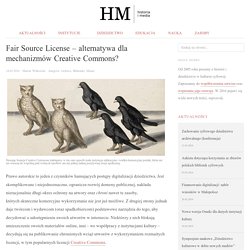
Prawo autorskie to jeden z czynników hamujących postępy digitalizacji dziedzictwa. Jest skomplikowane i niejednoznaczne, ogranicza rozwój domeny publicznej, nakłada nieracjonalnie długi okres ochrony na utwory oraz chroni nawet te zasoby, których skuteczne komercyjne wykorzystanie nie jest już możliwe. „Drapieżne” czasopisma w bibliotecznych bazach danych: jak bardzo należy się martwić? W 2009 roku prof. Jeffrey Beall – bibliotekarz i autor znanego bloga poświęconego zagadnieniom publikowania w modelu otwartego dostępu, zacząć tworzyć listę tzw. drapieżnych wydawców (ang. predatory publishers), czyli firm żerujących na modelu finansowania otwartych czasopism z opłat pobieranych od autorów artykułów. W należących do takich nieuczciwych wydawców, rzekomo naukowych i recenzowanych periodykach, ukazują się, z pominięciem procesu wydawniczego i ewaluacji, wszystkie opłacone teksty, także te niespełniające w żaden sposób kryteriów naukowości.
Większość piśmiennictwa poświęconego komunikacji naukowej i drapieżnym wydawcom koncentruje się na obawach środowiska naukowego związanych z publikowaniem w wątpliwej jakości czasopismach. "Fair" open access and the future of scientific publishing. When researchers, funders, universities and libraries started thinking about open access and improving scholarly communication in the late 1990s, the focus was on access. Indeed, the most immediate challenge was to make it possible to access scientific literature resulting from public funding. Criteria for Open Access and publishing – ScienceOpen.
In June 2015, the Committee on Publication Ethics, the Directory of Open Access Journals, the Open Access Scholarly Publishers Association and the World Association of Medical Editors updated their joint statement, originally published in 2013: the Principles of Transparency and Best Practice in Scholarly Publishing [1]. These principles were to a considerable extent derived from the criteria for the admission of journals into DOAJ that were expanded, updated and put into practice in March 2014 [2]. In addition, 50 Science Europe members issued a statement in April [3] this year on four new guidelines for publishers when providing payments/subsidies for Open Access venues. The first principle states that journals must be listed in DOAJ, Web of Science, Scopus or PubMed.
The second principle corresponds to one of the criteria that DOAJ uses for the Seal: authors must hold the copyright of their publication with no restrictions. DOAJ - o zaletach i problemach katalogowania społecznościowego czasopism otwartych.